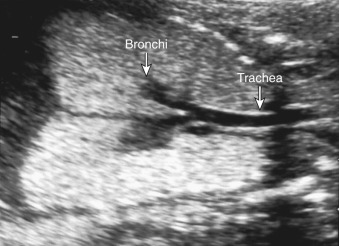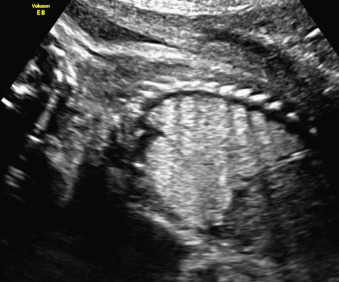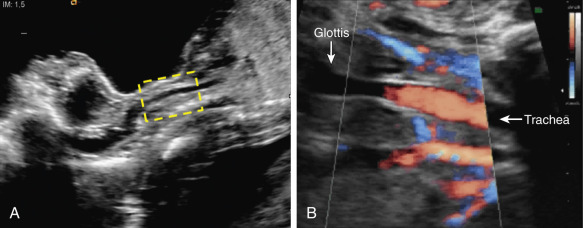Abstract
Congenital high airway obstruction syndrome (CHAOS) is a rare congenital anomaly consisting of complete intrinsic obstruction of the fetal upper airway, usually located at the level of the larynx or the trachea, that induces a progressive bilateral lung expansion with pulmonary developmental impairment and tracheobronchial dilatation secondary to retention of bronchial secretions. The diagnosis can be established by fetal ultrasound through identification of hyperexpanded and hyperechoic lungs, flattened diaphragm, tracheobronchial dilatation, and mediastinal compression. Fetal magnetic resonance imaging may play a useful role in identifying the level of obstruction and excluding additional malformations. It is usually a lethal anomaly, especially in the presence of fetal hydrops secondary to heart compression. However, some cases might respond positively to in utero treatment with fetal tracheoscopy or bronchoscopy or even an ex utero intrapartum treatment (EXIT) procedure.
Keywords
CHAOS, laryngeal atresia, bronchial atresia, tracheal atresia
Introduction
Congenital high airway obstruction syndrome (CHAOS) is a rare fetal anomaly that is associated with a high mortality (80%–100%). Prenatal diagnosis is clinically relevant in parental counseling and decision making regarding fetal surveillance, planning of fetal intervention, method of delivery, and postnatal management. CHAOS can be bilateral or unilateral (bronchial atresia).
Disorder
Definition
CHAOS is an extremely rare condition consisting of complete intrinsic obstruction of the fetal upper airway that can be located at the level of the larynx, trachea, or bronchi. Airway obstruction results in retention of bronchial secretions, which leads to abnormal expansion of the fetal lungs, marked tracheobronchial dilatation, and pulmonary developmental impairment.
Prevalence and Epidemiology
The incidence of CHAOS is unknown. Only a few cases have been reported in the literature.
Etiology, Pathophysiology, and Embryology
CHAOS may present as an isolated anomaly with a low risk of chromosomal anomalies, or in the context of a syndrome. When the obstruction is laryngeal, a significantly high proportion of cases are associated with Fraser syndrome, an autosomal recessive disease characterized by laryngeal atresia secondary to underlying fusion of the false vocal cords, cleft lip/palate, microphthalmia, syndactyly, ear anomalies, ambiguous genitalia, congenital heart disease, and severe oligohydramnios secondary to bilateral renal agenesis ( Chapter 129 ). In addition, other conditions can induce an extrinsic obstruction of the tracheobronchial tree, such as lymphatic congenital malformations, cervical teratoma, or vascular rings, such as double aortic arch or aberrant right subclavian artery.
The pathogenetic mechanism implicated for CHAOS includes intrinsic changes that prevented the normal development of the tracheobronchial tree during embryogenesis. The histopathologic findings of the fetal airways include the presence of webs, cysts, atresia, stenosis, or agenesis. Thus the cause of CHAOS can be a thin membrane, or web, obstructing the airway, or a more complex dysplasia and atresia of the affected portion of the airway. The obstructed flow of fetal lung fluid leads to intrapulmonary changes including alveolar hyperplasia and accumulation of fluid in the alveoli.
Manifestations of Disease
Clinical Presentation
CHAOS is characterized by retention of bronchial and alveolar secretions resulting in elevated intratracheal pressure and a significant increment in the amount of fluid within the lungs and tracheobronchial tree, leading to severely increased lung volume and tracheal dilatation. The massively enlarged lung(s) result(s) in an inversion of the normal diaphragmatic convexity and, if the airway obstruction is unilateral, a mediastinal shift. These findings can be detected on ultrasound (US) in the first trimester of pregnancy.
The diagnosis is usually made on examination of the fetal thorax, which is typically characterized by hyperexpanded and hyperechoic lungs ( Fig. 73.1 ), flattened diaphragms, and dilated airways below the level of the obstruction. When the diagnosis of CHAOS is made, fetal surveillance includes weekly evaluation of lung sizes, amniotic fluid, and US signs of hydrops. Evaluation of cardiac function parameters such as Doppler of the ductus venosus and tricuspid regurgitation should also be performed to identify the early occurrence of hydrops.

CHAOS is usually a lethal abnormality, especially in the presence of Fraser syndrome. In the absence of additional congenital malformations, the prognosis depends on the lung size and the presence of hydrops. In the absence of hydrops, some cases might be salvageable with proper perinatal management.
Imaging Technique and Findings
Ultrasound.
US usually shows signs related to complete airway obstruction. In a transverse view and at the level of the four-chamber view of the fetal heart, the lungs appear severely enlarged and highly hyperechoic. Secondary to the exceedingly high intrathoracic pressure and the degree of pulmonary expansion, the heart is squeezed into the middle of the fetal mediastinum between the lungs and shows a reduction of the cardiac angle. The sagittal and coronal views of the fetal thorax reveal two pathognomonic signs: flattening or inversion of the diaphragmatic convexity and markedly dilated airways, which allows observation of the entire tracheobronchial tree as a bronchogram ( Fig. 73.2 ). The dilated trachea and bronchi are better displayed with a coronal view of the fetal chest. The diameter can be measured in a coronal or sagittal view ( Fig. 73.3 ) and compared with normal reference ranges available in the literature. In addition, absence of flow in the trachea during fetal breathing or swallowing can be shown using color Doppler US. Extrapulmonary signs include nonimmune hydrops fetalis and placentomegaly secondary to cardiac failure or impeded venous return, or both, and polyhydramnios secondary to esophageal compression.












